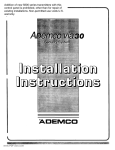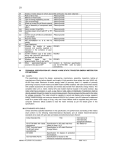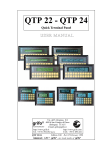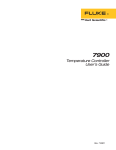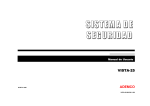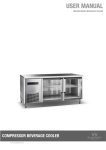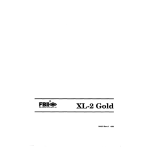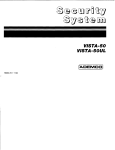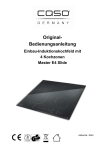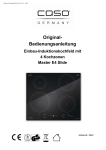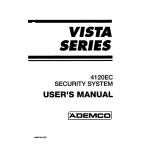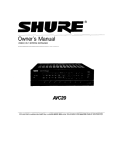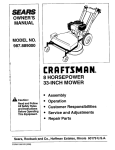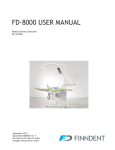Download VISTA-20 User Manual - Allied Fire & Security
Transcript
VISTA-20 N7527VI 4195 Technical Manuals Online! - http://www.tech-man.com ADEMCO -2- Technical Manuals Online! - http://www.tech-man.com TABLE OF CONTENTS CHIME MODE ..............................................................23 sYsTEMovERvlEw ....................................................4 Geneml ......................................................................4 A Partitioned System ................................................4 Zones ........................................................................4 Burglaty Protection .................................................5 Secun@Codes .........................................................5 Fire Protection .......................................................... 6 Alams .......................................................................6 Memotyof Alam ......................................................6 Phone Access &Voice Response ...........................6 PANIC KEYS ..... ..........................................................24 USING DEVICE COMMANDS ..................................... 25 USING THE KEYSWITCH ...........................................26 SECURITY CODES .....................................................27 General....................................................................27 Babysitter Code ......................................................27 Duress Code ...........................................................27 Quick Aming ..........................................................27 To Add or Change A User ...................................... 28 ENTRY/EXIT DELAYS ..................................................7 General lnfomation .................................................. 7 To Delete A User .....................................................28 Exit Alams ................................................................8 TESTING THE SYSTEM ..............................................29 ABouT THE KEYPADs ................................................9 FUNCTIONS OF THE KEYPADS ................................ 12 CHECKING FOR OPEN ZONES ................................. 14 ARMING PERIMETER ONLY (STAY) ......................... 15 ARMING PERIMETER ONLY (INSTANT) ................... 16 ARMING ALL PROTECTION (AWAY) ........................ 17 ARMING ALL PROTECTION (MAXIMUM) ................. 18 TROUBLE CONDITIONS ............................................31 FIRE ALARM SYSTEM ............................................... 33 NFPA RECOMMENDATIONS EMERGENCY ..................................... 34 EVACUATION ...................................... 35 YOUR SYSTEM ..................................36 QUICK GUIDE TO SYSTEM FUNCTIONS .................. 38 SUMMARY OF AUDIBLE NOTIFICATION .................40 GLossARY .................................................................4l INSURANCE CREDIT REQUEST FORM ....................47 INDEX .......................................................................... 50 MAINTAINING DISARMING AND SILENCING ALARMS ...................19 Memory of Alarm ....................................................2O BYPASSING PROTECTION ZONES .......................... 21 Quick Bypass ......................................................... 22 Displaying Bypassed Zones .................................. 22 -3- Technical Manuals Online! - http://www.tech-man.com SYSTEM General OVERVIEW Congratulations on your ownership of an Ademco Partitioned Security System. You’ve made a wise decision in choosing it, for it represents the latest in security protection technology today. Ademco is the world’s largest manufacturer of security systems and millions of premises are protected by Ademco systems. This system offers you three forms of protection: burglary, fire and emergency. Your system consists of at least one keypad which provides control of system operation, and includes various sensors which provide perimeter and interior burgla~ protection, plus smoke or combustion detectors designed to provide early warning in case of fire. The system uses microcomputer technology to monitor all protection zones and system status and provides appropriate information for display on the keypad(s) used with the system, and initiates appropriate alarms. Your system may also have been programmed to automatically transmit alarm or status messages over the phone lines to a central alarm monitoring station. A Partitioned System Simply stated, a partitioned system is a single physical alarm system that provides independent areas of protection intended for use by independent users. For the most part, you need not know about other users and their structure in the system, but from time to time, you may see display messages which indicate the system is in use by another user. Do not be concerned, this is normal. Zones Your system’s sensing devices have been assigned to various “zones.” For example, the sensing device on your Entry/Exit door may have been assigned to zone 01, sensing devices on windows in the master bedroom to zone 02, and so on. These numbers will appear on the display, along with a description for that zone (if programmed), when an alarm or trouble condition occurs. -4- Technical Manuals Online! - http://www.tech-man.com SYSTEM Burglary Protection OVERVIEW Your system provides four modes of burglary protection: STAY, AWAY, INSTANT and MAXIMUM, and allows you to BYPASS selected zones while leaving the rest of the system armed. You must turn on or “arm” the burglary protection portion of your system before it will sense burglary alarms. The system also provides a CHIME mode, for alerting users to the opening of protected doors and windows while the system is disarmed. Refer to the other sections of this manual for procedures for using these features. The following table lists the four different arming modes and the results of each. Arming Mode Security Codes Exit Delay Features For Each Arming Mode Entry Delay Perimeter Armed Interior Armed AWAY Yes Yes Yes Yes STAY INSTANT MAXIMUM Yes Yes Yes Yes No No Yes Yes Yes No No Yes At the time of installation, you were assigned a personal four-digit security code, known only to you. You must enter the security code when arming and disarming the system, and when performing other system functions. As an additional safety feature, other users who do not have a need to know your code can be assigned different security codes. Refer to the SECURITY CODES section for procedures on adding security codes to the system. -5Technical Manuals Online! - http://www.tech-man.com SYSTEM Fire Protection Memory OVERVIEW The fire protection portion of your security system (if used) is always active and will sound an alarm if a fire condition is detected. Refer to the FIRE ALARM SYSTEM section for important information concerning fire protection, smoke detectors and planning emergency exit routes from the premises, Alarms When an alarm occurs, both the keypad and external sounders will sound, and the keypad will display the zone(s) causing the alarm. If your system is connected to a central monitoring station, an alarm message will also be sent, To stop the alarm sounding, simply disarm the system. of Alarm When an alarm condition occurs, the keypad displays the number(s) of the zone(s) that caused the problem, and displays the type of alarm (ex. FIRE, ALARM). It remains displayed until it is cleared by disarming the system (see DISARMING THE SYSTEM section). Phone Access & Voice Response CapabiliW Your system may include a voice module that will permit you to access the system via a Touch-tone phone, either on-premises or by call-in when away. The phone access feature will enable you to do the following: ● ● Receive synthesized voice messages over the telephone regarding the status of the security system. Arm and disarm the system and perform most function commands via the telephone, with voice confirmation provided after each command entry. Complete information regarding the use of this feature is provided in a separate manual entitled PHONE ACCESS USER’S GUIDE, which accompanies the voice module. -6Technical Manuals Online! - http://www.tech-man.com ENTRY/EXIT General Information DELAYS Your system has preset time delays, known as exit delay and entry delay. Whenever you arm your system, exit delay gives you time to leave through the designated exit door without setting off an alarm. Exit delay begins immediately after entering any arming command, and applies to all modes of arming protection. If programmed, a slow beeping will sound throughout the exit delay period. Entry Delays give you time to disarm the system when you re-enter through the designated entrance door. But you must disarm the system before the entry delay period ends, or an alarm will occur. The keypad beeps during the entry delay period, reminding you to disarm the system. There are two entry delays (if programmed). The first is for your primary entrance and the second can be used for a secondary entrance, where a longer delay is required to walk to the keypad to disarm the system. The secondary entry delay is 30 seconds longer than your primary entry delay. You can also arm the system with no entry delay at all by using either INSTANT or MAXIMUM arming modes. These modes provide greater security while on the premises or while away for extended periods of time. See your installer for your delay times. Partition 1 Partition 2 Exit Delay: m Exit Delay: m seconds seconds -7Technical Manuals Online! - http://www.tech-man.com Entry Delay 1: m seconds Entry Delay 2: m seconds Entry Delay 1: m seconds Entty Delay 2: ~ seconds ENTRY/EXIT Ex[t Alarms minimizefalsealarms sent to the alarm monitoring company, your systemmay have To been programmed for this feature. Ask your installer if “Exit Alarm” is active for your system. ❑ Exit Alarm Active DELAYS Whenever you arm the system, the exit delay begins. If an entry/exit door or interior zone is faulted when the exit delay ends (e.g., exit door left open), the system sounds an alarm and starts the entry delay timer. If you disarm the system before the entry delay ends, the alarm sound stops and the message “CANCELLED ALARM” or “CA is displayed on the keypad, along with a zone number indicating the faulted zone. No message is sent to the alarm monitoring company. To clear the exit alarm condition, the open zone must be made intact; to clear the display, enter your code plus OFF, If you do not disarm the system before the entry delay ends, and an entry/exit door or interior zone is still open, the alarm sound continues and an “exit alarm” message is sent to the alarm monitoring company. The message “’’EXIT ALARM” or “EA” is displayed on the keypad, along with a zone number indicating the faulted zone. To stop the alarm, the system must be disarmed (your code plus OFF); to clear the display, enter your code plus OFF a second time. An “exit alarm” also results if an entry/exit door or interior zone is faulted within two minutes after the end of the exit delay. -8Technical Manuals Online! - http://www.tech-man.com Technical Manuals Online! - http://www.tech-man.com Technical Manuals Online! - http://www.tech-man.com ABOUT THE KEYPADS Fixed=Word Keypad Displays AWAY: STAY: All burglaryzones, interiorand perimeter,are armed. Perimeter burglary zones, windows & doors,are armed. such as protected INSTANT: Perimeter burglary zones armed and entry delay is turned off. BYPASS: One or more burglary protection zones have been bypassed. NOT READY: Appears when burglary portion of the system is not ready for arming (due to open protection zones). READY: The burglary system is ready to be armed. NO AC: Appears when AC power has been cut off. System is operating on backup battery power. AC: CHIME: BAT: ALARM: Appears when AC power is present. Appears when the CHIME feature is activated. Low battery condition in a wireless sensor (if zone TYPICAL FIXED-WORD CONSOLES I number displayed) or low system battery (if no zone numberdisplayed). Appears when an intrusion has been detected and the system is armed (also appears during a fire alarm or audible emergency alarm). Accompanied by the protection zone in alarm. CHECK FIRE: Appears when a malfunction is discovered in the system at any time or if an open is detected in a FIRE zone at any time or a fault in a DAY/NIGHT burglary zone during a disarmed period. Accompanied by a display of zone number in trouble. Appears when a fire alarm is present. Accompanied by a display of the zone in alarm. -11Technical Manuals Online! - http://www.tech-man.com FUNCTIONS 1. 2. 3. OF THE KEYPADS ALPHA DISPLAY WINDOW: A l-line or 24ine, Liquid Crystal Display (LCD). Displays protection point identificationand system status, messages, and user instructions. ~ KEY: Disarmsthe burglaryportionof the system, silencesalarmsand audibletroubleindicators,and clears visualalarmtroubleaftertheproblemhas been corrected. -1 ~[ KEY: Arms the perimeter burglary 8. KEY: Tests thesystem andalarrm sounder. BYPASS KEY: Removes individual protection zones -] KEY: Arms in manner similar to STAY mode, but turns off the entry delay period, offering greater security while inside and not expecting any late arrivals. An alarm will occur immediately upon opening any perimeter protection point, including entry delay zones 9. 10. -J KEY: Allows the entry of additional user codes that can be given to other users of the system. H KIEY: Turns the C1-lltvfEmode on and off. When on, any entry through a protected delay or perimeter zone while the system is disarmed will cause a tone to sound at the Keypad(s). 11. When depressed prior to arming the m ‘Ey’ system, the keypad will display all open protection zones within the keypad’s home partition. 12. ~ KEY: Permits ARMING of the system without use .f a security code (“Quick Arm”, if programmed). Also used to view the second line of single-line Alpha keypads. 13. KEYS O-9: Used to enter your individual security access code(s). I MAXIMUM] KEY: Arms in manner similar to AWAY mode, but eliminates the entry delay period, thus providing maximum protection. An alarm will occur immediately upon opening any protection point, including entry delay zones. ~1 from being monitored by the system. Displays currently bypassed protection zones. protection, guarding protected doors, windows and other perimeter protection points, and sounds an alarm if one is opened. Interior protection is not armed, which allows movement within your house without causing an alarm. Entrance can be made through an entry delay zone without causing an alarm if the system is disarmed before the entry delay time expires. 5. 7. KEY: Completely arms both perimeter and interior burglary protection for backup protection by sensing an intruder’s movements through protected interior areas as well as guarding protected doors, windows, etc. Entrance can be made through an entry delay zone without causing an alarm if the system is disarmed before the entry delay time expires. 4. 6. -12Technical Manuals Online! - http://www.tech-man.com 14, POWER/READY INDICATOR: On keypads with a “POWER” LED, primary power is on when lit. If off, system is operating on backup battery power. On keypads with a “READY” LED, system is ready to be armed if lit, while unlit indicates system is not ready (a zone is open). 15. ARMED INDICATOR: (RED) Lit when the system has been armed (STAY, AWAY, INSTANT or MAXIMUM). 16. INTERNAL SOUNDER: Source of audible internal warning and confirmation sounds, as well as alarms (see “Summary of Audible Notifications”). 17. A-B-C PANIC KEYS: Some kevDads use key pairs to activate panic a(arms, rather than individual keys. Refer to the PANIC KEYS section for descriptions of these keys. IMPORTANT!: When you use the keypad to enter codes and commands, press the keys within 2 seconds of one another If 2 seconds elapse without a key depression, the entty is aborted and must be repeated r — ~ / ‘ e \ SRhl. 1 1 READY— / 1 A /@ ( SHOWN WITH KEYPAD COVER REMOVED Ci=---f%”l”l / /l\ @~(@@ TYPICAL ALPHA CONSOLE Fixed-Word Consoles are functionally similar, except for screen displays. -13Technical Manuals Online! - http://www.tech-man.com CHECKING FOR OPEN ZONES ❑ Before arming your system, all protected doors, windows and other protection zones Using the READY Key must be closed or bypassed (see BYPASSING section), Otherwise the keypad will display a “Not Ready” message, Using the READY key will display all zones that are faulted, making it easier for you to secure any open zones. To show faulted zones: Note: A green READY indicator (if present) on the keypad will be lit if the system is ready to be armed. If not lit, the system is not ready. READY 1“ ❑ PRESS THE READY KEY Do not enter security code, but simply press the READY key. SECURE FAULTED ZONES Typical fault display shows open zones. Secure or bypass the zones displayed before arming the system. 2“E!EEEZI 3“EZEEI SYSTEM CAN BE ARMED The “Ready” message will be displayed when all protection zones have been either closed or bypassed. You may now arm the system as usual. -14Technical Manuals Online! - http://www.tech-man.com ARMING PERIMETER ONLY (With Entry Delay ON) Using the ~ STAY key Use this key when you are staying home, but might expect someone to use the entrance door later. When armed in STAY mode, the system will sound an alarm if a protected door or window is opened, but you may otherwise move freely throughout the premises. Late arrivals can enter through the entrance door without causing an alarm, but they must disarm the system within the entry delay period or an alarm will occur. Close all protected perimeter windows and doors before arming (see CHECKING FOR OPEN ZONES section). The green READY indicator (if present) on the keypad should be lit if the system is ready to be armed. STAY I“mmu+czl (Security Code) 2“PZEI ENTER SECURITY Example: ~ LISTEN PI ~ CODE ~] THEN PRESS STAY then press the STAY key. FOR 3 BEEPS The keypad will beep three times and will display the armed STAY message. The red ARMED indicator also lights. -15Technical Manuals Online! - http://www.tech-man.com ARMING PERIMETER ONLY (With Entry Delay OFF) ~ Using the INSTANT Key Use this key when you are staying home and do not expect anyone to use the ‘ntrance ‘OO’. When armed in INSTANT mode, the system will sound an alarm if a protected door or window is opened, but you may otherwise move freely throughout the premises. alarm will also sound immediately if anyone opens the entrance door. The Close all protected perimeter windows and doors before arming (see CHECKING FOR OPEN ZONES section). The green READY indicator (if present) on the keypad should be lit if the system is ready to be armed. INSTANT ‘“ Emtm+izl (Security Code) 2. fl/ffiED +IDSTflNT+ ENTER SECURITY CODE Example: ~~ ~] ~] ~] LISTEN THEN PRESS INSTANT then press the INSTANT key. FOR 3 BEEPS The keypad will beep three times and will display the armed INSTANT message. The red ARMED indicator also lights. -16- Technical Manuals Online! - http://www.tech-man.com ARMING ALL PROTECTION (With Entry Delay ON) ~ Using the AWAY Key Use this key when no one will be staying on the premises. When armed in AWAY mode, the system will sound an alarm if a protected door or window is opened, or if any movement is detected inside the premises. You may leave through the entrance door during the exit delay period without causing an alarm. You may also re-enter through the entrance door, but must disarm the system within the entry delay period or an alarm will occur. Close all protected perimeter windows and doors before arming (see CHECKING FOR OPEN ZONES section). The green READY indicator (if present) on the keypad should be lit if the system is ready to be armed. AWAY 1“❑ ICI OCI+PI (Security Code) 2“EEEEI ENTER Example: SECURiTY ~ CODE PI PI ~] THEN PRESS AWAY then press the AWAY key. LISTEN The keypad will beep twice, or beep continuously if exit warning has been programmed for your system, and displays the armed AWAY message. The red ARMED indicator also lights. The “You May Exit Now” portion of the message disappears when the exit delay expires. -17Technical Manuals Online! - http://www.tech-man.com “ ARMING ALL PROTECTION (With Entry Delay OFF) ~ Using the MAXIMUM Key Use this key when the premises will be vacant for extended periods of time such as vacations, etc., or when no one will be moving through protected interior areas. When armed in MAXIMUM mode, the system will sound an alarm if a protected door or window is opened, or if any movement is detected inside the premises. You may leave through the entrance door during the exit delay period without causing an alarm, but an alarm will be sounded as soon as someone re-enters. Close all protected perimeter windows and doors before arming (see CHECKiNG FOR OPEN ZONES section). The green READY indicator (if present) on the keypad shouid be iit if the system is ready to be armed. 1“ ❑ MAXIMUM cmcl+lz.1 (SecurityCode) 2. G ~~pJ~D+fq~)fffl~fl. ENTER Example: SECURiTY ~ ~ CODE PI ~] THEN PRESS MAXIMUM then press the MAXIMUM key. LiSTEN The keypad will beep twice, or beep continuously if exit warning has been programmed for your system, and will display the armed MAXIMUM message (AWAY/lNSTANT on fixed-word keypads). The red ARMED indicator aiso lights. The “You May Exit Now” portion of the message disappears when the exit delay expires. -18Technical Manuals Online! - http://www.tech-man.com DISARMING ~ Using the OFF Key AND SILENCING ALARMS Use the OFF key to disarm the system and to silence alarm and trouble sounds. See “SUMMARY OF AUDIBLE NOTIFICATION” section for information which will help you to distinguish between FIRE and BURGLARY alarm sounds. IMPORTANT: If you return and the main burglary sounder is on, DO NOT enter the premises, but call the police from a nearby safe location. If you return after an alarm has occurred and the main sounder has shut itself off, the keypad will beep rapidly upon entering, indicating that an alarm has occurred during your absence and an intruder may still be on the premises. LEAVE IMMEDIATELY and CONTACT THE POLICE from a nearby safe location. To disarm the system and silence burglary alarms: 1“ ❑ ltlclcl+m OFF (Security Code) 2“EEZI ENTER SECURITY CODE, THEN PRESS OFF Example: ~ ~ ~ ~1 then press the OFF key. LISTEN FOR 1 BEEP The “Ready” message will be displayed (if no alarms have occurred while armed) and the keypad will beep once to confirm that the system is disarm-cd. -19Technical Manuals Online! - http://www.tech-man.com DISARMING AND SILENCING ALARMS (Continued) Memory of Alarm If an alarm occurs, the keypad displays the zone number (s) that caused the alarm and the type of alarm. These messages remain displayed until cleared by a user. To clear the display, note the zone number displayed (enter your security code and press the OFF key). and enter an OFF sequence If the ‘Ready” message will not display, go to the displayed zone and correct the fault (close windows, etc.). If the fault cannot be corrected, notify your alarm company. -20- Technical Manuals Online! - http://www.tech-man.com BYPASSING Using the ~ BYPASS Key PROTECTION ZONES This key is used when you want to arm your system with one or more zones intentionally unprotected. Bypassed zones are unprotected and will not cause an alarm when violated while your system is armed. All bypasses are removed when an OFF sequence (security code plus OFF) is performed. Bypasses are also removed if the arming procedure that follows the bypass command is not successful. The system will not allow fire zones to be bypassed. To bypass zones, the system must be disarmed first. BYPASS nnn+m 2.❑ n I. ❑ (securitycode) (Zone Numbers) 3“= Typicalbypassmessage 4“ OISRR17ED8!iPRS5 = ENTER SECURITY CODE THEN PRESS BYPASS Example: PI ~] ~~ PI then press the BYPASS key. ZONE NUMBERS Enter the zone number(s) for the zones to be bypassed (e.g., 01,02,03, etc.). Important! All single-digit numbers must be preceded by a zero (for example, enter 01 for zone 1). ENTER The keypad will display the word BYPASS along with ‘“’T bypassed zone number. Wait for these zones to each be displayed, to be sure that intended zones are bypassed.ARM AS USUAL Arm the,$ystem as usual when the keypad displays the ‘Ready message. (Continued) Technical Manuals Online! - -21http://www.tech-man.com BYPASSING Quick Bypass PROTECTION ZONES (Continued) Your system may allow you to easily bypass all open (faulted) zones without having to enter zone numbers individually. Ask your installer if this feature is active. BYPASS 1“ ❑ mtl+m TEE&&&d Typical bypass message 3- Displaying Bypassed Zones ENTER SECURITY Example: ~ (Security Code) Pa D15RR17EDBYPRS5 CODE THEN ~\ PI ~] PRESS BYPASS then press the BYPASS key. WAIT [n a few moments, all open zones will be displayed along with the word BYPASS. Wait for these zones to be displayed before arming. Arming the system before zones are displayed eliminates all bypasses. ARM AS USUAL Arm the system as usual when the keypad displays the “Ready” message. For determining what zones have been previously bypassed. Bypassed zones can be displayed only when the system is disarmed, and when the “Bypass” message shown in step 3 above is displayed. 1“ ❑ (Security Code) BYPASS mucl+m 2-Typical bypass message ENTER SECURITY CODE THEN PRESS BYPASS Example: ❑ PI PI ~ then press the BYPASS key. In a few moments, all open zones will be sequentially ‘A’T displayed along with the word BYPASS. -22Technical Manuals Online! - http://www.tech-man.com Using the ~ Key Your system can be set to alert you to the opening of a door or window while it is disarmed by using CHIME mode. When activated, three beeps will sound at the keypad whenever a protected perimeter door or window is opened. Pressing the READY key will display the open protection points. Note that the Chime mode can be activated only when the system is disarmed. To turn Chime Mode on: 1“ ❑ CHIME ENTER SECURITY CODE THEN PRESS CHIME lclcm+m Example: ~] ~1 ~[ ~[ (Security Code) 2“E!EZKI? The then press the CHIME key. Chime” message displays while chime mode is To turn Chime Mode off: CHIME 1“ ❑ ICI CICJ+P!IENTER (Security Code) SECURITY CODE THEN PRESS CHIME Example: ~1 ~1 [~] ~] 2“EEEI “Ew then press the CHIME key. The Chime” message disappears from the display. -23Technical Manuals Online! - http://www.tech-man.com PANIC KEYS (FOR MANUALLY ACTIVATING SILENT AND/OR AUDIBLE ALARMS) Your system may have been programmed to use special keys to manually activate panic functions. The functions that might be programmed are listed below. See your installer for the function(s) that may have been programmed for your system. Using Panic Keys Active Panic Functions Your installer I should note the functions that are are active in your system. - Keys 1 and * 3 and # A* B* 96 99 95 99 c* 96 * and # I ● Zone 95 Function May not be present on your keypad(s). To use a paired key panic function, simply press both keys of the assigned pair at the same time. If your keypad has lettered keys for panic functions, press the designated key and hold down for at least 2 seconds to activate the panic function. Types of Panic Alarms * If your system is connected to an alarm monitoring com~anv. 7 A silent emergency sends an alarm signal to the alarm monitoring company,* but there will be no audible alarms or visual displays. An audible emergency sends an emergency message to the alarm monitoring company* and sounds a loud, steady alarm at your keypad and at any external sounders that may be connected (ALARM plus a zone number is also displayed). -24Technical Manuals Online! - http://www.tech-man.com emergency alarm sends an A personal emergency message to the alarm monitoring company* and sounds at keypads, but not at external sounders. (ALARM plus a zone number is also displayed) A fire alarm sends a fire alarm message to the alarm monitoring company* and uniquely activates keypad and any external sounders (FIRE plus a zone number is also displayed). USING DEVICE COMMANDS General Information To activate devices Your system may be set up so that certain lights or other devices can be turned on or off by using the device command from the keypad. Ask your installer if this has been done in your system. If programmed for your system, some devices may activate automatically upon certain system conditions. In this case, the following commands can be used to override the device activation. See your installer for a full explanation of this feature. ENTER SECURITY CODE THEN PRESS # + 7 + DEVICE NUMBER tlDoo+m+7+D (Security Code) (Device Number) Examp/e: ~] PI ~] ~[ then press #, then press 7, then enter the number representingthe device you wish to activate. See your installerfor device numbersassignedfor your system. To deactivate devices ENTER SECURITY CODE THEN PRESS # + 8 + DEVICE NUMBER rlclclcl+lXl+8+n (SecurityCode) (Device Number) Examp/e: ~] ~] ~] ~] then press #, then press 8, then enter the number representing the device you wish to deactivate. See your installer for device numbers assigned for your system. Device Description Device 1 5 2 6 3 7 4 6 –25Technical Manuals Online! - http://www.tech-man.com Description USING THE KEYSWITCH General Your system may be equipped with a keyswitch for use when arming and disarming. A red and green light on the keyswitch plate indicate the status of your system as follows: Green Light: This indicator lights when the system is disarmed and ready to be armed (no open zones). If the system is disarmed and the green light is off, it indicates the system is not ready (one or more zones are open). Red Light: Arming This indicator lights when the system is armed or memory of alarm exists. Lit Steady: System is armed in AWAY mode. Slow Flashing: System is armed in STAY mode. Rapid Flashing: Memory of alarm, indicating an alarm has occurre-d . To arm in the AWAY mode, turn the key to the right for 1/2 second and release. Keypads will beep twice and the red light will stay on steady. I To arm in the STAY mode, turn the key to the right and hold for longer than 1 second, then release. Keypads will beep three times and the red light will flash slowly. Disarming ‘RED GREEN To disarm the system, turn the key to the right and release. If an alarm has occurred, the red light will be flashing rapidly (memory of alarm). 1 -26Technical Manuals Online! - http://www.tech-man.com SECURITY General Information CODES As an additional safety feature, other users who do not have a need to know your code can be assigned different security codes. These secondary users are identified by “user numbers,” which are selected when assigning a user’s security code. You can assign up 14 additional user codes (user numbers 03-16), including the babysitter and duress codes. Note that the master (primary) user of the system is the only one who can assign codes to secondary (or temporary) users, and is user number 02; user number 01 is reserved for the installer of the system. All codes can be used interchangeably when performing system functions (a system armed with one user’s code can be disarmed by another user’s code), with the exception of the babysitter code described below. Babysitter Code This code can be used to arm the system in assigned partitions, but cannot disarm the system unless the system was armed with this code. This code is typically assigned to someone (such as a babysitter) who has a need to arm/disarm the system only at certain times. The babysitter code is assigned to user 15. The user of this code should not use the “Quick Armingn feature described below. Duress Code This feature is intended for use when you are forced to disarm or arm the system under threat. When used, the system will act normally, but can silently notify the alarm monitoring company of your situation, if that service has been provided. Duress code is assigned to user 16. Important: This code is useful only when the system is connected monitoring company. Quick Arming to a alarm Note that if “Quick Arming” was programmed by the installer, the ~ key can be pressed in place of the security code when arming the system. The security code must always be used to disarm the system, however. -27Technical Manuals Online! - http://www.tech-man.com SECURITY To Add a User or Change a User’s Code Important: Temporary users of the system (e.g., babysitters, cleaning staff, etc.) should not be shown how to use any system function they do not need to know, such as bypassing protection zones for example. Sequential key depressions for all steps in a procedure must be made within 2 seconds of one another, or else the entire entry is aborted and must be repeated from its beginning (e.g., perform steps 1, 2, and 3 below with no delay between steps). 1“ ❑ CODE ENTER lnclcl+m (Master Code) Example: 2“UCI 3“ ❑ clcm ❑ lnnn+m (Master Code) 2“00 (User 3. Number) ----------- ~ [~] then press the CODE key. CODE ENTER MASTER CODE THEN PRESS CODE KEY Example: PI ~ PI ~] then pressthe CODE key. ENTER USER NUMBER Enter the 2-digit User Number (03-1 6) for the user whose code you are deleting. STOP Wait (about 3 seconds) until the keypad beeps once before pressing any other key. The code is automatically Technical Manuals Online! - PI ~ ENTER USER’S CODE Enter the new 4-digit security code for that user. (User’s Code) 1“ CODE THEN PRESS CODE KEY MASTER ENTER USER NUMBER Enter the 2-digit User Number (03-1 6) for the user you are adding or changing. (User Number) To Delete a User CODES -28– http://www.tech-man.com deleted. TESTINO THE SYSTEM (TO BE CONDUCTED ~ Using the TEST Key WEEKLY) The TEST key puts your system into the Test mode, which allows each protection point to be checked for proper operation. The keypad sounds a single beep every 40 seconds as a reminder that the system is in the Test mode. Note: An alarm message will not be sent to be sent to your alarm monitoring company during the following tests. ‘“EEEEI“SARMTHESYSTEM Disarm the system and close all protected windows, doors, etc. The “Ready” message should be displayed and the green READY indicator (if present on the keypad) should also be lit . 2“ ❑ TEST Jcltlcl+m (SecurityCode) ENTER THE SECURITY Example: ~ ~\ ~] ~ CODE THEN PRESS TEST then press the TEST key. 3. LISTEN. The external sounder should sound for 2 seconds and then turn off. If the sounder does not sound, CALL FOR SERVICE IMMEDIATELY. 4. FAULT ZONES. Open each protected door and window in turn and listen for three beeps from the keypad. Identification of each faulted protection point should appear on the display. The display will clear when the door or window is closed. (’Continued) -29- Technical Manuals Online! - http://www.tech-man.com TESTING THE SYSTEM Walk in front of any interior motion detectors (if used) and listen for three beeps. The identification of the detector should appear on the display when it is activated. The display will clear when no motion is detected. Note that if wireless motion detectors are used, there is a 3-minute delay between activations. This is to conserve battery life. To test all smoke detectors, follow the manufacturer’s instructions. The identification of each detector should appear on the display when each is activated. If a problem is experienced with any protection point (no confirming sounds, no display), CALL FOR SERVICE IMMEDIATELY. When all protection points have been checked and are intact (closed), there should be no zone identification numbers displayed on the keypad. When testing is completed, exit the TEST mode by continuing with step 5. 5“ ❑ OFF lclcln+m (SecurityCode) EXIT TEST MODE Enter your security code and press the OFF key. If the test mode is inadvertently automatically turns off after 4 hours. Technical Manuals Online! - http://www.tech-man.com -30- left active, it TROUBLE ~piOS[ “Check” Displays ‘ Nole that zone number 9 represents a problem with wireless receivers or other system devices, which are not user serviceable. CALL FOR SERVICE IMMEDIATELY. CONDITIONS The word CHECK on the Keypad’s display, accompanied by a rapid “beeping” at the Keypad, indicates that there is a trouble condition in the system. The displays in parenthesis may appear on non-alpha keypads when the associated trouble condition is present. To silence the beeping sound for “check” conditions, press any key. 1. CHECK+ Zone Descriptors Indicates that a problem exists with those zone(s)*. First, determine if the zone(s) displayed are intact and make them so if they are not. If the zone uses a wireless detector, check that changes in the room (moving furniture, televisions, etc.) are not blocking wireless signals from the detector. If the problem has been corrected, the zone descriptor(s) and CHECK should disappear. If not, key an OFF sequence (security code plus OFF) to clear the display. A CHECK condition can also indicate a wiring problem. If the “check” display persists, CALL FOR SERVICE IMMEDIATELY. Note that the system will not allow arming if a CHECK condition exists. To arm the system with a CHECK condition present, you must first bypass the zone(s) having the CHECK condition. 2. Telco Fault (or CHECK and zone 94) If the telephone line monitor feature has been programmed for your system, this display indicates that the telephone line has been disconnected or cut. In some systems, this display will be accompanied by a trouble sound from the keypad and the external CONTACT YOUR SERVICE sounder may be activated. COMPANY IMMEDIATELY. To silence the trouble sound, enter your security code plus OFF. -31Technical Manuals Online! - http://www.tech-man.com TROUBLE Conditions I ● The beeping that 1 accompani& a low battery display (items 4 and 5) can be stopped by entering an OFF seauence (code + OFF) J ImEzEEl (Continued) FAILURE (or FC) Indicates that a failure has occurred in the telephone communication portion of your system. CALL FOR SERVICE IMMEDIATELY. 3. COMM. 4. SYSTEM LO BAT (or BAT with no zone No.) Indicates that a low system battery condition exists, and accompanied by a once-per-minute “beeping”* at the Keypad. CALL FOR SERVICE IMMEDIATELY. 5. LO BAT+ zone descriptor (or BAT with zone No.) Indicates that a low battery condition exists in the wireless transmitter** displayed, and accompanied by a once-per-minute “beeping”* at the Keypad. CALL FOR SERVICE IMMEDIATELY. 6. MODEM (or CC) Indicates that the control is on-line with the central station’s remote computer. The control will not operate while on-line. Wait a few minutes. The display should disappear. 7. POWER indicator (if present) is off. AC LOSS is displayed (or NO AC) The system is operating on battery power only. If only some lights are out on the premises, check circuit breakers and fuses and reset or replace as necessary. CALL FOR SERVICE IMMEDIATELY if AC power cannot be restored to the system. 8. Busy-Standby If this remains displayed for more than 1 minute, system is disabled. CALL FOR SERVICE AT ONCE. The keypad is not receiving signals from the control. back-up Long Range Radio If programmed, communication has failed. CALL FOR SERVICE AT ONCE. COMM (or dl) 9. OPEN CIRCUIT (or OC) 10. Long Rng Trbl (or bF) -32Technical Manuals Online! - http://www.tech-man.com FIRE ALARM SYSTEM (IF INSTALLED) General Your fire alarm system (if installed) is active 24 hours a day, providing continuous protection. In the event of an emergency, the installed smoke and heat detectors will automatically activate you security system, triggering a loud, interrupted sound from the Keypad. An interrupted sound will also be produced by optional exterior sounders. A FIRE message will appear at your Keypad and remain on until you silence and clear the alarm display. In Case Of Fire 1. Should you become aware of a fire emergency before your detectors sense the problem, go to your nearest Keypad and press the single panic key (or panic key pair) assigned as FIRE emergency (if programmed by the installer) and hold down for at least 2 seconds. The alarm will sound. 2. Evacuate all occupants from the premises. 3. If flames and/or smoke are present, leave the premises and notify your local Fire Department immediately. 4. [f no flames or smoke are apparent, investigate the cause of the alarm. The zone descriptor of the zone(s) in an alarm condition will appear at the Keypad. Silencing A Fire 1. Silence the alarm by pressing the OFF key. To ciear the alarm display, enter your code and press the OFF key again. 2. If the Keypad indicates a trouble condition after the second OFF sequence? check that smoke detectors are not responding to smoke or heat producing objects in their vicinity. Should this be the case, eliminate the source of heat or smoke. 3. If this does not remedy the problem, there may still be smoke in the detector. Clear it by fanning the detector for about 30 seconds. 4. When the problem has been corrected, clear the display by entering your code and pressing the OFF key. -33Technical Manuals Online! - http://www.tech-man.com NATIONAL FIRE PROTECTION ASSN. RECOMMENDATIONS ON SMOKE DETECTORS With regard to the number and placement of smoke/heat detectors, we subscribe to the recommendations contained in the National Fire Protection Association’s (NFPA) Standard #74 noted below. Early warning fire detection is best achieved by the installation of fire detection equipment in all rooms and areas of the household as follows: A smoke detector installed outside of each separate sleeping area, in the immediate vicinity of the bedrooms and on each additional story of the family living unit, including basements and excluding crawl spaces and unfinished attics. In addition, the NFPA recommends that you install heat or smoke detectors in the living room, dining room, bedroom(s), kitchen, hallway(s), attic, furnace room, utility and storage rooms, basements and attached garages. A k&E!_LM ■ Smoke Detectors for Minimum Protection ~ Smoke Detectors for Additional Protection A Heat-Activated Detectors I BASEMENT -34Technical Manuals Online! - http://www.tech-man.com EMERGENCY 1qpf’@’ EVACUATION Establish and regularly practice a plan of escape in the event of fire. The following steps are recommended by the National Fire Protection Association: 1. Position your detector or your interior and/or exterior sounders so that they can be heard by all occupants. 2, Determine two means of escape from each room, One path of escape should lead to the door that permits normal exit from the building. The other may be a window, should your path be unpassable. Station an escape ladder at such windows if there is a long drop to the ground, 3. Sketch a floor plan of the building. Show windows, doors, stairs and rooftops that can be used to escape. Indicate escape routes for each room. Keep these routes free from obstruction and post copies of the escape routes in every room. 4. Assure that all bedroom doors are shut while you are asleep. This will prevent deadly smoke from entering while you escape. 5. Try the door. If the door is hot, check your alternate escape route. If the door is cool, open it cautiously. Be prepared to slam the door if smoke or heat rushes in. 6. When smoke is present, crawl on the ground. Do not walk upright, since smoke rises and may overcome you. Clearer air is near the floor. 7, Escape quickly; don’t panic. 8. Establish a common meeting place outdoors, away from your house, where everyone can meet and then take steps to contact the authorities and account for those missing. Choose someone to assure that nobody returns to the house — many die going back. “Iml *3-+ l“FL •1 BACK 1 ❑ 0 D ❑ FRour 0 I -35Technical Manuals Online! - http://www.tech-man.com MAINTAINING w YOUR SYSTEM Taking Care of Your System The components of your security system are designed to be as maintenance-free as possible. However, to make sure that your system is in reliable working condition. 1. Test your system weekly. 2. Test your system after any alarm occurs (see TESTING THE SYSTEM), Replacing Batteries in Wireless Sensors Each wireless sensor in your system has a 9-volt or 3-volt battery. The system detects a low battery in any wireless sensor, including smoke detectors, the optional personal emergency transmitter, and the optional portable wireless keypad. (A low battery in a portable wireless keypad is detected as soon as one of its keys is pressed, and the wired keypad will display “00”.) Alkaline batteries provide a minimum of 1 year of operation, and in most units and applications, provide 2-4 years of service. 3-volt lithium batteries provide up to 4 or more years of operation. Actual battery life will depend on the environment in which the sensor is used, the number of signals that the transmitter in the sensor has had to send, and the specific type of sensor. Factors such as humidity, high or low temperatures or large swings in temperature, may all lead to the reduction of actual battery life in an installation. If you have a low battery in a wireless sensor, a low battery message is displayed on the keypad. In addition, a battery-operated smoke detector with a low battery also emits a single “chirp”sound approximately once every 20-30 seconds, identifying itself as the smoke detector with the weak battery. Note: The low battery message comes on as a warning that battery replacement in indicated sensor(s) is due within 30 days. In the meantime, a sensor causing a low battery indication is still fully operational. Important: Use only batteries recommended by your installer as replacement. –36Technical Manuals Online! - http://www.tech-man.com MAINTAINING YOUR SYSTEM Silencing Low Battety Warning Tones at the Keypad You can silence the keypad’s warning tones by pressing the OFF key, but the keypad’s low battery message display will remain on as a reminder that you have a low battery condition in one or more of your sensors. When you replace the weak battery with a fresh one, the sensor will send a “good battery” signal to the control as soon as the sensor is activated (opening/closing of door, window, etc.), causing the low battery display to turn off. If the sensor is not activated, the display will automatically clear within approximately 1 hour. Routine Care . Treat the components of your security system as you would any other electrical equipment. Do not slam sensor-protected doors or windows. ● Keep dust from accumulating on the keypad and ail protective sensors, particularly on motion sensors and smoke detectors. ● The keypad and sensors should be cleaned carefully with a dry soft cloth. Do not spray water or any other fluhi on the units. -37Technical Manuals Online! - http://www.tech-man.com QUICK GUIDE TO SYSTEM FUNCTIONS FUNCTION PROCEDURE COMMENTS Check Zones Press [*] Do this to view faulted zones when system not ready. Arm System Enter code Press arming key desired (AWAY, STAY, INSTANT, Do this to arm the system in the mode selected. Disarm System Bypass zones MAXIMUM) Entercode PressOFF [11 Enter code Press BYPASS [6] Enter zone numbers to be bypassed (use 2-digit entries) Quick Bypass Enter code Press BYPASS [61 and stoD Do this to disarm the system and silences alarms. Do this to bypass protection zones. Bypassed zones are unprotected and will not cause an alarm if violated. Do this to bypass all faulted zones automatically, if programmed. Mode OF Enter code Press CHIME [9] Chime Mode OFf Enter code Press CHIME [9] Do this to turn on chime mode. Keypad will sound if doors or windows are violated while system disarmed. Test Mode ON Do this to enter test mode. Sounds alarm sounder and allows sensors to be tested. Do this to turn test mode off. System returns to normal mode. Chime Test Mode OFF Enter code Press TEST [5] Enter code Press OFF [1] Do this to turn chime mode off. -38Technical Manuals Online! - http://www.tech-man.com QUICK GUIDE TO SYSTEM FUNCTIONS FUNCTION PROCEDURE COMMENTS Add or Change a User Enter master code Press CODE [8] Enter user’s 2-digit user No. Enter code for that user Do this to add or change a user code. Delete a User Enter master code I Press CODE [8] I~~f~dser number,to be Do this to delete a user code from the system, I I -39Technical Manuals Online! - http://www.tech-man.com SUMMARY OF AUDIBLE (ALPHA DISPLAY - NOTIFICATION KEYPADS) SOUND CAUSE LOUD, INTERRUPTED* Keypad & External LOUD, CONTINUOUS Keypad & External FIRE ALARM FIRE is displayed; descriptor of zone in alarm is displayed. BURGLARY/AUDIBLE EMERGENCY ALARM ALARM is displayed;descriptorof zone in alarm is also displayed, ONE SHORT BEEP (not repeated) Keypad only a. SYSTEM DISARM b. SYSTEM ARMING ATTEMPT WITH AN OPEN ZONE. c. BYPASS VERIFY a. DISARMED/READY TO ARM is displayed. b. The number and descriptor of the open protection zone is displayed. ONE SHORT BEEP (o:~cw$~ seconds) SYSTEM IS IN TEST MODE Opened Zone identifications will appear, ONE BEEP every40 sec. Keypadonly TWO SHORT BEEPS Keypad only THREE SHORT BEEPS Keypad only LOW BATTERY AT A TRANSMITTER LO BAT displayed with description of transmitter. ARM AWAY OR MAXIMUM ARMED AWAY or ARMED MAXIMUM is displayed. Red ARMED indicator is lit. a. ARM STAY OR INSTANT a. ARMED STAY or ARMED INSTANT is displayed. Red ARMED indicator i:s lit. b. CHIME displayed, descriptor of open protection zone will be displayed if the [*] key is pressed. DISPLAY c. Numbers and descriptors of the bypassed protection zones are displayed (One beep is heard for each zone displayed). Subsequently, the following is displayed: DISARMED BYPASS Ready to Arm b. ZONE OPENED WHILE SYSTEM IS IN CHIME MODE. RAPID BEEPING Keypad only SLOW BEEPING Keypad only * If a bell is used as external a. TROUBLE b. MEMORY OF ALARM a. EXIT DELAY WARNING (if programmed) b. ENTRY DELAY WARNING sounder, fire alarm is pulsed a. CHECK displayed. Descriptor of troubled protection zone is displayed. b. FIRE or ALARM IS displayed; descriptor of zone in alarm is displayed. a, ARMED AWAY or ARMED MAXIMUM is displayed along with You May Exit Now b. DISARM SYSTEM OR ALARM WILL OCCUR is displayed. Exceeding thte delay time without dissrming causes alarm. ring; burglary/audible emergency is steady ring. –40Technical Manuals Online! - http://www.tech-man.com GLOSSARY The following terms are used throughout the manual. ARM/DISARM: KEYPAD: ZONE: PARTITION: BYPASS: DELAY ZONE: “Armed” simply means that the burglary portion of your system is turned ON and is in a state of readiness. “Disarmed” means that the burglary system is turned OFF, and must be rearmed to become operational. However, even in a “disarmed” state, “emergency” and “fire” portions of your system are still operational. This is the area on your Keypad containing numbered pushbuttons similar to those on telephones or calculators. These keys control the arming or disarming of the system, and perform other functions which were previously described in this manual. A specific area of protection. An independent group of zones that can be armed and disarmed without affecting other zones or users. To disarm a specific area of burglary protection while leaving other areas operational. An area of protection containing doors most frequently used to enter or exit (typically, a front door, back door, or door from the garage into the building). The delay zone allows sufficient time for authorized entry or exit without causing an alarm. Consult your installer for the entry and exit delay times that have been set for your system during installation and record them in the space provided in this manual on page 7. DAY/NIGHT ZONE: An area of protection whose violation causes a trouble indication during the disarmed (DAY) mode and an alarm during the armed (NIGHT) mode. -41Technical Manuals Online! - http://www.tech-man.com UL NOTICE: This is a “GRADE A“ system. FEDERAL COMMUNICATIONS This equipment has been tested to FCC requirements statement for your information: COMMISSION (FCC) and has been found acceptable Part 15 STATEMENT for use. The FCC requires the following This equipment generates and uses radio frequency energy and if not installed and used properly, that is, in strict accordance with the manufacturer’s instructions, may cause interference to radio and television reception. It has been type tested and found to comply with the limits for a Class B computing device in accordance with the specifications in Part 15 of FCC Rules, which are designed to provide reasonable protection against such interference in a residential installation. However, there is no guarantee that interference will not occur in a particular installation. If this equipment does cause interference to radio or television reception, which can be determined by turning the equipment off and on, the user is encouraged to try to correct the interference by one or more of the following measures: If using an indoor antenna, have a quality outdoor antenna installed. Reorient the receiving antenna until interference is reduced or eliminated. ● Move the receiver away from the cent roi/commu nicator. ● Move the antenna leads away from any wire runs to the controllcommunicator. ● Plug the controlfcommunicator into a different outlet so that it and the receiver are on different branch circuits. If necessary, the user should consult the dealer or an experienced radioltelevision technician for additional suggestions. The user or installer may find the following booklet prepared by the Federal Communications Commission helpful: “Interference Handbook. This booklet is available from the U.S. Government Printing Office, Washington, DC 20402. ● ● The user shall not make any changes or modifications to the equipment unless authorized by the Installation Instructions or User’s Manual. Unauthorized changes or modifications could void the user’s authority to operate the equipment. IN THE EVENT OF TELEPHONE OPERATIONAL PROBLEMS In the event of telephone operational problems, disconnect the control by removing the plug from the RJ31 X (CA38A in Canada) telephone wall jack. We recommend that your certified installer demonstrate disconnecting the phones on installation of the system. Do not disconnect the phone connection inside the controllcommunicator. Doing so will result in the loss of your phone lines. If the regular phone works correctly after the controljcommunicator has been disconnected from the phone lines, the controllcommunicator has a problem and should be returned for repair. If upon disconnection of the controvcommunicator, there is still a problem on the line, notify the telephone company that they have a problem and request prompt repair sewice. The user may not under any circumstances (in or out of warranty) attempt any service or repairs to the system. It must be returned to the factory or an authorized service agency for all repairs. -42– Technical Manuals Online! - http://www.tech-man.com FEDERAL COMMUNICATIONS COMMISSION (FCC) Part 68 NOTICE This equipment complies with Part 68 of the FCC rules. On the front cover of this equipment is a label that contains, among other information, the FCC registration number and ringer equivalence number (REN) for this equipment. If requested, this information must be provided to the telephone company. This equipment uses the following jacks: An RJ31 X is used to connect this equipment to the telephone network. The REN is used to determine the quantity of devices which may be connected to the telephone line, Excessive RENs on the telephone line may result in the devices not ringing in response to an incoming call. In most, but not all areas, the sum of the RENs should not exceed five (5.0). To be certain of the number of devices that may be connected to the line, as determined by the total RENs, contact the telephone company to determine the maximum REN for the calling area. If this equipment causes harm to the telephone network, the telephone company will notify you in advance that temporary discontinuance of service may be required. If advance notice is not practical, the telephone company will notify the customer as soon as possible. Also, you will be advised of your right to file a complaint with the FCC if you believe necessary. The telephone company may make changes in its facilities, equipment, operations, or procedures that could affect the operation of the equipment. If this happens, the telephone company will provide advance notice in order for you to make the necessary modifications in order to maintain uninterrupted service. If trouble is experienced with this equipment, please contact the manufacturer for repair and warranty information. If the trouble is causing harm to the telephone network, the telephone company may request you remove the equipment from the network until the problem is resolved. There are no user serviceable components in this product, and all necessary repairs must be made by the manufacturer. Other repair methods may invalidate the FCC registration on this product. This equipment cannot be used on telephone company-provided subject to state tariffs. coin service. Connection to Party Line Service is This equipment is hearing-aid compatible. When programming or making test calls to an emergency number, briefly explain to the dispatcher the reason for the call. Perform such activities in the off-Desk hours; such as earlv morning or late evening. -43Technical Manuals Online! - http://www.tech-man.com WARNING! THE LIMITATIONS OF THIS ALARM SYSTEM While this system is an advanced design security system, it does not offer guaranteed protection against burglary or fire or other emergency. Any alarm system, whether commercial or residential, is subject to compromise or failure to warn for a variety of reasons. For example: ● Intruders may gain access through unprotected openings or have the technical sophistication to bypass an alarm sensor or disconnect an alarm warning device. ● Intrusion detectors (e.g. passive infrared detectors), smoke detectors, and many other sensing devices will not work without power. Battery operated devices will not work without batteries, with dead batteries, or if the batteries are not put in properly. Devices powered solely by AC will not work if their AC power supply is cut off for any reason, however briefly. ● ● ● ● Signals sent by wireless transmitters may be blocked or reflected by metal before they reach the alarm receiver. Even if the signal path has been recently checked during a weekly test, blockage can occur if a metal object is moved into the path. A user may not be able to reach a panic or emergency button quickly enough. While smoke detectors have played a key role in reducing residential fire deaths in the United States, they may not activate or provide early warning for a variety of reasons in as many as 35% of all fires, according to data published by the Federal Emergency Management Agency. Some of the reasons smoke detectors used in conjunction with this System may not work are as follows. Smoke detectors may have been improperly installed and positioned. Smoke detectors may not sense fires that start where smoke cannot reach the detectors, such as in chimneys, in walls, or roofs, or on the other side of closed doors. Smoke detectors also may not sense a fire on another level of a residence or building, A second floor detector, for example, may not sense a first floor or basement fire. Moreover, smoke detectors have sensing limitations. No smoke detector can sense every kind of fire every time. In general, detectors may not always warn about fires caused by carelessness and safety hazards like smoking in bed, violent explosions, escaping gas, improper storage of flammable materials, overloaded electrical circuits, children playing with matches, or arson. Depending upon the nature of the fire ancf/or the locations of the smoke detectors, the detector, even if it operates as anticipated, may not provide sufficient warning to allow all occupants to escape in time to prevent injury or death. Passive Infrared Motion Detectors can only detect intrusion within the designed ranges as diagramed in their instalIation manual. Passive Infrared Detectors do not provide volumetric area protection. They do create multiple beams of protection, and intrusion can only be detected in unobstructed areas covered by those beams. They cannot detect motion or intrusion that takes place behind walls, ceilings, floors, closed doors, glass partitions, glass doors, or windows. Mechanical tampering, masking, painting or spraying of any material on the mirrors, windows or any part of the optical system can reduce their detection ability. Passive Infrared Detectors sense changes in temperature; however, as the ambient temperature of protected area approaches the temperature range of 90° to 105”F, the detection performance can decrease. -44Technical Manuals Online! - http://www.tech-man.com WARNING! THE LIMITATIONS OF THIS ALARM SYSTEM (continued) ● ● ● Alarm warning devices such as sirens, bells or horns may not alert people or wake up sleepers if they are located on the other side of closed or partly open doors. If warning devices sound on a different level of the residence from the bedrooms, then they are less likely to waken or alert people inside the bedrooms. Even persons who are awake may not hear the warning if the alarm is muffled from a stereo, radio, air conditioner or other appliance, or by passing traffic. Finally, alarm warning devices, however loud, may not warn hearing-impaired people or waken deep sleepers. Telephone lines needed to transmit alarm signals from a premises to a central monitoring station may be out of service or temporarily out of service. Telephone lines are also subject to compromise by sophisticated intruders. Even if the system responds to the emergency as intended, however, occupants may have insufficient time to protect themselves from the emergency situation. In the case of a monitored alarm system, authorities may not respond appropriately. This equipment, like other electrical devices, is subject to component failure. Even though this equipment is designed to last as long as 10 years, the electronic components could fail at any time. The most common cause of an alarm system not functioning when an intrusion or fire occurs is inadequate maintenance. This alarm system should be tested weekly to make sure all sensors and transmitters are working properly. Installing an alarm system may make one eligible for lower insurance rates, but an alarm system is not a substitute for insurance. Homeowners, property owners and renters should continue to act prudently in protecting themselves and continue to insure their lives and propetty. ● We continue to develop new and improved protection devices. Users of alarm systems owe it to themselves and their loved ones to learn about these developments. -45Technical Manuals Online! - http://www.tech-man.com CANADIAN DEPARTMENT OF COMMUNICATIONS STATEMENT (DOC) NOTICE AVIS The Canadian Department of Communications label identifies certified equipment. This certification means that the equipment meets certain telecommunications network protective, operational and safet requirements. The Department does not guarantee the equipment WII 1’ operate to the user’s satisfaction. Before installing this aquipmant, users should ensure that it is permissible to be connected to the facilities of the local telecommunications company. Tha equipment must also be installed using an acceptable method of connection. lnsomecases, thecompany's inside winngassociated witha single line individual service may be extended by means of certified connector assembly (telephone axtension cord). The customer should be aware that comphance with the above conditions may not prevent degradation of service in some situations. Repairs to certHied equipment should be made by an authorized Canadian maintenance facility designated by the supplier. Any repairs or alterations made by the user to this equipment, or equipment malfunctions, may give the telecommunications company cause to request the user to disconnect the equipment. Users should ensure for their own protection that the electrical ground connections of the power utility, telephone lines and internal metallic water pipe system, if present, are connected together. This precaution may be particularly important in rural areas. Caution: User should not attempt to make such connetilons themselves, but should contact the appropriate electric inspection authority, or electrician, as appropriate. The Load Number (LN) assigned to each terminal device denotes the percentage of the total load to be connected to a telephone loop which is used by the device, to prevent overloading. The termination on a loop may consist of any combination of devices subject only to the requirement that the total of the Load Numbers of all the devices does not exceed 100. L’&iquette du ministbre des Communications du Canada identifie Ie materiel homologu6. Cette 6tiquette certifie que Ie mat6riel est conforme a certaines normes de protection, d’ex Ioitation et de s6curit6 des rdseaux de t616communications. Le minists re n’assure toutefois .DaSaue . Ie mak%iel fonctionnera /1 la satisfaction de I’utilisateur. Avant d’installer ce mat&iel, I’ufilisateur doit s’assurer qu’il est permis de Ie raccorder aux installations de I’entreprise locale de t616communications. Le matkmiel doit 6galement etre instal16 en suivant une m6thode accepk$e de raccordement. Dans certains cas, Ies fiis interieurs de I’entreprise utilises pour un service individualA la Iigne unique peuvent ~tre prolong6sau mo en dun dispositif homologu4 de 7 raccordement (cordon prolongateur t66phonique interne). L’abonn6 ne doit pas oublier qu’il est possible que la conformity aux conditions 6nonc6es ci-desaus n’empbchet pas la d6~radation du sewice clans cerfaines situations. Actuellement, Ies entrepnses de t61ecommunicafions ne permettent pas que I’on raccorde Ieur mat6riel aux prises d’abonrv% sauf clans Ies cas precis prevus par Ies tarifs parficuliers de ces entreprises. Les reparations du matt%iel homologu6 doivent 6tre effectu6es pas un centre d’entretien canadien autoris6 d&si rr~ par Ie fournisseur. La compagnie de t616communicafions peut ~emander a Icutilisateur de d6brancher un appareil A la suite de reparations ou de modifications effectu6es par i’utilisateur ou & cause de mauvais fonctionnement. Pour sa propre protection, I’utilisateur doit s’assurer que tous Ies fils de mise en terre de la source d’her~ie electrique, des Iignes t61ephoniques de r6seau de conduites d’eau s’Il y en a, soient raccord6s ensemble. Cette precaution est particuli~rement importance clans Ies regions rurales. Avertisaement: L’utilisateur ne doit pas tanter de faire Ces raccordements lui-m~me; il doit avoir recours A un service d’inspection des installations 61ectriques, ou h un tfdectricien,selon Ie cas. ,. J~ (IC) assign6 ?I chaque dispositif terminal pour eviter toute surcharge indique ie pourcentage de la charge totale qui peut fXre raccordt$ ~ un circuit t616phonique bouc16 utilise par ce dispositif. La terminaison du circuit bouc16 peut 6tre constitute de n’importe quelle combinaison de disposififs, pourvu que la somme des indices de charge de I’ensemble des dispositifs ne d&passe pas 100. -46Technical Manuals Online! - http://www.tech-man.com OWNER’S INSURANCE PREMIUM CREDIT REQUEST This form should be completed and forwarded to your homeowner’s insurance carrier for possible premium credit, A. GENERAL INFORMATION: insured’sNameandAddress: PolicyNo.: insuranceCompany: ADEMCO’S VISTA 20 Type of Aiarm: ❑ Other ❑ Burgiaty ❑ Fire Servicedby instailedby: Name Name Address Address B. NOTIFIES (Insert B = Burgiary, F = Fire) Central Station ❑ Fire Dept. Poiice Dept. Local Sounding Device Name: Address: Phone: C. POWERED BY: A.C. With Rechargeable Power Suppiy D, TESTING: Both ❑ Quarterly ❑ Monthiy m Weekly ❑ oontinuedon otherside -47- Technical Manuals Online! - http://www.tech-man.com Other OWNER’S INSURANCE PREMIUM CREDIT REQUEST (cont.) E. SMOKE DETECTOR LOCATIONS ~ Furnace Room Kitchen ~ Living Room Basement ❑ ❑ F. BURGLARY DETEC ING DEVICE LOCATIONS: Basement Door ~ Front Door ❑ ❑ ❑ ❑ ❑ ❑ Dining Room ❑ ❑ Rear Door ❑ Bedrooms ❑ Ist Floor Windows q All Accessible Openings, Including Skylights, Air Conditioners and Vents All windows Interior locations G. ADDITIONAL PERTINENT INFORMATION: Signature: Date: -48- Technical Manuals Online! - http://www.tech-man.com Attic Hall All ExteriorDoors SERVICING INFORMATION Your local Ademco dealer is the person best qualified to service your alarm system. Arranging some kind of regular service program with him is advisable. Your localAdemco dealer is: Address: Phone: -49- Technical Manuals Online! - http://www.tech-man.com - INDEX l-Line Alpha Keypads 2-Partition AWAY .... .. ... .. .. ... ......9 Arming ... .. .. .. ... .. .. 17 AC LoSS .. ... .. . .. .. ... .. ..... .. ..... .. ..... .....32 Add A User .... .. ..... .. .. ... .. ... ... .... .. .. ...28 Alpha Keypad Audible Away .. ... .. .. ... .. .. ... .. ... .... .......9 Emergency . .. ... .. ....5. Away Mode Babysitter .. ... .. .....11. 11, 12, 17,26, . .. . . ... .. .. ... ... .. ....12. Code 24, 40 38,40 17,26 .. .. ..... ... .. ... .... ... ..... 27 Burglary Protection Bypass ... .. .... . .. ... .. .. ... .. ... .. .. 12,14,21 . .. ... .... ... ....4. 5, 41 Check . ..... .. .. .. . .. .... ... ..... .. ..... .. ...11. 31 Chime . .. .... ... .. . .. .. ... ..... .. ..... .. .. ... ....5. 7 Chime Mode . . . .. ... .. .....5.9. 11,38,40 Comm. Failure ................................32 Delete A User ...........................28. 39 Disarming .....................20. 26,38, 41 Dkiplaying Bypassed Zones ............ 22 Duress Code ............................13. 27 Emergency Evacuation ..................35 Entry Delay .............................5. 7, 11 Exit Delay ...5. 7, 8, 17, 18, 19,40, 41 Exit Alarm ......................................... 8 Fire .......... 4, 6, 11, 20, 21,33, 35,41 Fire Alarm ................................ 33, 40 Fire Protection ................................. 6 Fire Escape .................................... 35 Fixed-Word Keypads .................9. 11 Instant ...............5. 11, 12, 16,38,40 Instant Mode ................................. 16 Keypads ..................9. 10, 11, 12, 13 Keyswitch ...................................... 26 Lo Bat ...................................... 32,40 Low Banery ............11.32.36. 37, 40 Maximum .............5. 7, 12, 19, 38, 40 Maximum Mode ............................. 19 Memory Of Alarm ..........6. 20, 26, 40 Modem Comm ............................... 32 National Fire Protect Assn. .....34. 35 Not Ready ............. 11, 14, 18,26,38 Off Key .......................................... 20 Panic Functions ............................. 24 Panic Keys ............................... 12,33 Partitioned System .......................... 4 -50- Technical Manuals Online! - http://www.tech-man.com Personal Emergency Quick Arming . . ........... .. ... ... 24 .. ............ ... ..... ...... .. ... 27 Quick Bypass ..... ... ... ..... ... ...... .........22 Ready Key .. ... .. ........ ... . .. ......... . 14, 33 Security Codes . .... ..... ..... .... . 5, 27, 28 Silence Alarm ................................ 20 Silent Emergency .......................... 24 Sounder .......76. 9, 12,20, 24,29,40 Special AWAY Arming .................... 17 Stay ............. 5, 11, 12, 15,26,38,40 Stay Mode ......................... 12, 15,26 System Lo Battery ......................... 32 Temporary Users ........................... 28 Test Key ........................................ 29 Test Mode .................... 29, 30, 38, 40 Trouble Conditions ..................31. 32 User Number ..................... 27, 38, 39 Voice Module ................................... 6 Wireless Sensor ...................... 11, 36 Zones .. ... ... ........ .. ... ... ... .. ......... .. ... .. . 4 ADEMCO ONE YEAR LIMITED WARRANTY Alarm Device Manufacturing Company, a Division of Pittway Corporation, and its divisions, subsidiaries and affiliates ~Seller”), 165 Eileen Way, Syosset, New York 11791, warrants its security equipment (the “product”)to be free from defects in materials and workmanship for one year from date of original purchase, under normal use and service. Seller’s obligation is limited to repairing or replacing, at its option, free of charge for parts, labor, or transportation, any product proven to be defective in materials or workmanship under normal use and service, Seller shall have no obligation under this warranty or otherwise if the product is altered or improperly repaired or serviced by anyone other than the Seller. In case of defect, contact the security professional who installed and maintains your security equipment or the Seller for product repair. Thie one year Limited Warranty is in lieu of all other express warranties, obligations or liabilities. THERE ARE NO EXPRESS WARRANTIES, WHICH EXTEND BEYOND THE FACE HEREOF. ANY IMPLIED WARRANTIES, OBLIGATIONS OR LIABILITIES MADE BY SELLER IN CONNECTION WITH THIS PRODUCT, INCLUDING ANY IMPLIED WARRANTY OF MERCHANTABILITY, OR FITNESS FOR A PARTICULAR PURPOSE OR OTHERWISE, ARE LIMITED IN DURATION TO A PERIOD OF ONE YEAR FROM THE DATE OF ORIGINAL PURCHASE. ANY ACTION FOR BREACH OF ANY WARRANTY, INCLUDING BUT NOT LIMITED TO ANY IMPLIED WARRANTY OF MERCHANTABILITY, MUST BE BROUGHT WITHIN 12 MONTHS FROM DATE OF ORIGINAL PURCHASE. IN NO CASE SHALL SELLER BE LIABLE TO ANYONE FOR ANY CONSEQUENTIAL OR INCIDENTAL DAMAGES FOR BREACH OF THIS OR ANY OTHER WARRANTY, EXPRESS OR IMPLIED, OR UPON ANY OTHER BASIS OF LIABILITY WHATSOEVER, EVEN IF THE LOSS OR DAMAGE IS CAUSED BY THE SELLER’S OWN NEGLIGENCE OR FAULT. Some states do not allow limitation on how long an implied warranty lasts or the exclusion or limitation of incidental or consequential damages, so the above limitation or exclusion may not apply to you. Seller does not represent that the product may not be compromised or circumvented; that the product will prevent any personal injury or property loss by burglary, robbery, fire or otherwise; or that the product will in all cases provide adequate warning or protection. Buyer understands that a properly installed and maintained alarm may only reduce the risk of a burglary, robbery, fire or other events occurring without providing an alarm, but it is not insurance or a guarantee that such will not occur or that there will be no personal injury or property loss as a result. CONSEQUENTLY, SELLER SHALL HAVE NO LIABILITY FOR ANY PERSONAL INJURY, PROPERTY DAMAGE OR OTHER LOSS BASED ON A CLAIM THE PRODUCT FAILED TO GIVE WARNING. HOWEVER, IF SELLER IS HELD LIABLE, WHETHER DIRECTLY OR INDIRECTLY, FOR ANY LOSS OR DAMAGE ARISING UNDER THIS LIMITED WARRANTY OR OTHERWISE, REGARDLESS OF CAUSE OR ORIGIN, SELLER’S MAXIMUM LIABILITY SHALL NOT IN ANY CASE EXCEED THE PURCHASE PRICE OF THE PRODUCT, WHICH SHALL BE THE COMPLETE AND EXCLUSIVE REMEDY AGAINST SELLER, This warranty gives you specific legal rights, and you may also have other rights which vary from state to state. No increase or alteration, written or verbal, to this warranty is authorized. -51- Technical Manuals Online! - http://www.tech-man.com [ADEMCOJ ALARM DEVICE MANUFACTURING A DIVISION OF PlllWAY 165 Eileen Way, Syosset, CORPORATION CORPORATION New York 11791 Copyright @ 1995 PITTWAY CORPORATION N7527V1 4195 Technical Manuals Online! - http://www.tech-man.com




















































